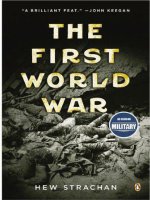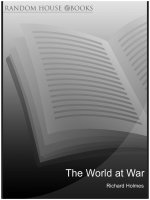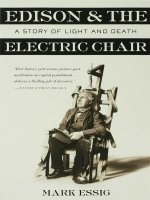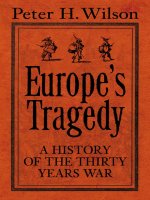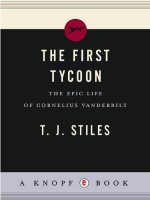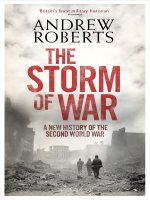Richard holmes the world at war (v5 0)
Bạn đang xem bản rút gọn của tài liệu. Xem và tải ngay bản đầy đủ của tài liệu tại đây (9.93 MB, 545 trang )
Table of Contents
Title
Title Page
Copyright Page
FOREWORD BY SIR JEREMY ISAACS
INTRODUCTION
INTERVIEWEES
CHAPTER 1 GERMANY'S HITLER
CHAPTER 2 JAPAN'S MILITARISM
CHAPTER 3 APPEASEMENT AND PHONEY WAR
CHAPTER 4 BATTLE OF THE ATLANTIC 1939–40
CHAPTER 5 FALL OF FRANCE AND DUNKIRK
CHAPTER 6 WINSTON CHURCHILL
Picture Section 1
CHAPTER 7 BATTLE OF BRITAIN AND THE BLITZ
CHAPTER 8 NORTH AFRICA AND THE BALKANS
CHAPTER 9 BATTLE OF THE ATLANTIC 1940–41
CHAPTER 10 BARBAROSSA
CHAPTER 11 PEARL HARBOR
CHAPTER 12 FALL OF MALAYA AND RETREAT FROM BURMA
CHAPTER 13 BATTLE OF THE ATLANTIC 1942–43
CHAPTER 14 BATTLE OF THE PACIFIC 1942–43
Picture Section 2
CHAPTER 15 VICTORY IN NORTH AFRICA
CHAPTER 16 STALINGRAD AND THE EASTERN FRONT
CHAPTER 17 STRATEGIC BOMBING: ROYAL AIR FORCE
CHAPTER 18 THE HOLOCAUST
CHAPTER 19 CASABLANCA AND TEHRAN
CHAPTER 20 ANGLO-AMERICAN RELATIONS
CHAPTER 21 ECONOMIC AND SCIENTIFIC WARFARE
CHAPTER 22 HOME FRONT
CHAPTER 23 OCCUPATION AND RESISTANCE
Picture Section 3
CHAPTER 24 STRATEGIC BOMBING: US ARMY AIR FORCE
CHAPTER 25 THE ITALIAN CAMPAIGN
CHAPTER 26 D-DAY IN NORMANDY
CHAPTER 27 BATTLE OF THE PACIFIC 1944–45
CHAPTER 28 RETURN TO BURMA
CHAPTER 29 WESTERN EUROPE
CHAPTER 30 YALTA AND POLAND
Picture Section 4
CHAPTER 31 FALL OF BERLIN
CHAPTER 32 ENDURING THE UNENDURABLE
CHAPTER 33 SETTLING ACCOUNTS
CHAPTER 34 FALLING OUT: VIEWS IN 1970–72
CHAPTER 35 REFLECTIONS
APPENDIX
ABOUT THE WORLD AT WAR TV SERIES
AWARDS
EPISODE SUMMARY
PERMISSIONS
INDEX OF INTERVIEWEES
GENERAL INDEX
The definitive history of the Second World War
Footnotes
THE
WORLD
AT WAR
THE
WORLD
AT WAR
THE LANDMARK ORAL HISTORY
FROM THE PREVIOUSLY UNPUBLISHED ARCHIVES
RICHARD HOLMES
This eBook is copyright material and must not be copied, reproduced, transferred, distributed, leased,
licensed or publicly performed or used in any way except as specifically permitted in writing by the
publishers, as allowed under the terms and conditions under which it was purchased or as strictly
permitted by applicable copyright law. Any unauthorised distribution or use of this text may be a
direct infringement of the author's and publisher's rights and those responsible may be liable in law
accordingly.
ISBN 9781407029177
Version 1.0
www.randomhouse.co.uk
3 5 7 9 10 8 6 4 2
Published in 2007 by Ebury Press, an imprint of Ebury Publishing
A Random House Group Company
Text copyright © Richard Holmes 2007
The World at War is a trademark of FremantleMedia Limited.
Licensed by FremantleMedia Enterprises.
Richard Holmes has asserted his right to be identified as the author of this Work in accordance with
the Copyright, Designs and Patents Act 1988
This electronic book is sold subject to the condition that it shall not by way of trade or otherwise, be
lent, resold, hired out, or otherwise circulated without the publisher's prior consent in any form other
than that in which it is published and without a similar condition including this condition being
imposed on the subsequent purchaser
The Random House Group Limited Reg. No. 954009
Addresses for companies within the Random House Group
can be found at www.randomhouse.co.uk
A CIP catalogue record for this book is available from the British Library
Designed and set by seagulls.net
ISBN: 9781407029177
Version 1.0
To buy books by your favourite authors and
register for offers visit www.rbooks.co.uk
FOREWORD
BY SIR JEREMY ISAACS
All film-makers shoot more footage than they use; The World at War was no exception. We always
knew we had more good stuff than could conceivably be crammed into twenty-six hours of
commercial television – each 'hour' only fifty-two minutes, thirty seconds long, to be precise. We
never kept a strict tally, but I'd guess the ratio of newsreel printed to that used was about fifteen to
one; for interviews it was higher still, well over twenty to one. The first assemblies of strong,
relevant material ran at over three hours; hard choices always had to be made to get each episode
down to transmittable length.
We shot, from the outset, for the series and for the record. What was omitted was left, not on the
cutting-room floor, but in the Imperial War Museum (IWM). Thames Television, at its all-round best
the finest of the ITV franchise holders, sturdily footed the bill.
In a way, the money Thames spent was public money. The ITV companies, fifteen of them, enjoyed
near monopolies, in their own areas, of television advertising revenue. In February 1971, after years
of pressure, the government agreed to change the basis of the special levy on ITV franchises – the
price they paid for their monopoly – from a tax on revenue to a tax on profit; their income would no
longer be taxed at source. The condition was that the companies spend, and be seen to spend, more on
programmes. I went at once to my bosses at Thames and suggested we make a history of the Second
World War. A few weeks later, on April Fool's Day 1971, we started work. Our principal
collaborator was the IWM; its director, Noble Frankland, our historical adviser. It was a condition of
the contract that all the original footage we shot be deposited in the IWM's archive. There it has lain
to this day.
The World at War's key ingredients were the image and the word, newsreel and eye-witness
interview. Music and narration held all together. Some programmes went short of pictures; there is
little visual record of war at sea, or acts of resistance, or of genocidal gas-chambers. Those episodes
relied on interviews. One episode, on Stalingrad, used no witnesses; no Red Army veterans would
face the camera in 1972–73, at the height of the Cold War. But those were the exceptions. For the
most part we reckoned to use newsreel and interviews, split fifty-fifty; so only about thirteen hours of
interview made it to the screen.
Some voices are heard only for a moment. An American paratrooper, who dropped in France
before the D-Day landing, tells us: 'I was afraid. I was nineteen, and I was afraid.' I hear him still.
Others, particularly the leaders, talked at greater length. What interviewer, researcher or producer,
facing a Supreme Commander, a presidential aide, the Foreign Secretary, an SS General, could resist
seeking an overview, a tour d'horizon? It might serve in several programmes, after all. As you read
these pages, remember The World at War's interviewers; they did a fine job.
The World at War took fifty of us three years to make: we talked to hundreds of survivors and
printed a million feet of film. When it was finished – the final episode screened in May, 1974 – we
made three lengthy specials from the ample surplus to hand. Then, the team broke up; each moved on
to other things. Making The World at War took over our lives, but we never thought of transferring
what we'd done to other media. Now, triumphantly, the voices we recorded speak again on the
printed page. Rereading the transcripts today, I am impressed by how successfully, in skilled hands,
they transfer to print; vivid, articulate, revelatory.
Television history is narrative history. Several interpretations of a strategic decision may be worth
considering, but the film-maker must choose one, and stay with it. On the page, there is time and
freedom to review the options. On complex issues, a wealth of opinion is easily displayed, and
differing experiences related. In commissioning this oral history, Ebury Press has taken a visionary
initiative. Richard Holmes has done a superb job of selection, and of organising the mass of material.
On many topics he presents a broader and more nuanced account than did TV's linear narrative. His
book deserves a vast readership. I salute him.
Jeremy Isaacs describes the making of The World at War in Look Me in the Eye: A Life in
Television, published by Little Brown 2006.
INTRODUCTION
I always rather dislike being called a television historian, preferring to see myself as an historian
who enjoys talking about his subject: in that sense, at least, television, books and lectures are simply
different parts of the same process. Yet there is no doubt that I am exactly of an age to have been
profoundly influenced by television history. The BBC series The Great War appeared in my last year
at school, and I can well remember watching some of its episodes on a tiny television in the worn and
fusty setting of a house-room at my boarding school. It introduced the real complexities of its subject
to an audience that either knew nothing about the war or had accepted at face value some of the more
egregious comments that then passed for fact. Despite the best endeavours of Dr Noble Frankland,
then Director of the Imperial War Museum (whose generosity in reducing the charges that the museum
might otherwise have charged for copyright material had made the series possible in the first place),
it took some extraordinary liberties with its use of visual images, blurring the boundaries between
reconstructed and actuality sequences. It nevertheless deserves the much overused description
'landmark', and, as Dr Frankland has written, 'it launched the idea of history on screen'.
In 1973, almost a decade later, when I was in the early stages of my career as a military historian,
pecking away at my doctoral thesis with the one-finger typing that kept the makers of Tipp-Ex in
profits, the Thames Television series The World at War appeared. I was captivated at once. The
poignant rise and fall of Carl Davis's music; the montage of extraordinary facial photographs in the
pre-title sequence, each successively burned away to reveal another, like pages of an album seared
by heat, and the mellifluous enunciation of Laurence Olivier, all had me enthralled even before I had
properly watched a single episode. Once I began to watch, I was hooked. The breadth of the 26episode series, shaped and sustained by the directing brain of Jeremy Isaacs, the series producer, was
simply breathtaking. This was no narrowly Eurocentric story, but just what its name implied, the
Second World War from background to legacy, and from the freezing waters of the North Atlantic
through the sands of the Western Desert to the jungles of Burma. What struck me then was the
remarkable quality of the eyewitnesses who had been interviewed, and the way in which the words of
the men and women who had 'fought, worked or watched' were put at the very centre of the television
treatment. For instance, I shall never forget hearing Christabel Bielenberg, a British woman married
to a German lawyer, describing the rise of Hitler: suddenly the events of 1933–36 were not something
that had happened long ago and far away, but a personal story being told by a familiar voice. She was
to call her book The Past is Myself, and reading the transcripts of her interview I see how apt that
phrase is, and just what an impact personal accounts like this have had on my own development as a
historian.
Looking at the series when it was first screened I was struck by its success in gaining access to so
many men and women who had seen the wider picture, and having now had access to the full range of
interviews, I am even more impressed. To select a few names, almost at random, there are the words
of John Colville, Churchill's urbane and perceptive Private Secretary; Hasso-Eccard Freiherr von
Manteuffel, one of the most successful practitioners of armoured warfare; Vera Lynn, 'The Forces'
Sweetheart', whose songs caught the mood of Britain at war; 'Manny' Shinwell, veteran Labour
politician; Francis de Guingand, Montgomery's Chief of Staff; Albert Speer, Hitler's architect turned
Armaments Minister, with his insider's view of power politics in the Third Reich, and two of the
apostles of air power, Arthur Harris of the RAF's Bomber Command and Curtis LeMay of what was
then still the United States Army Air Force.
But of course this was not a series that concentrated on 'captains and the kings'. There were many
ordinary men and women too – American, British, Canadian, German, Japanese – telling us about the
extraordinary times they lived through, and who, but for their necessarily brief appearances, might
otherwise have left no mark on history. A mother describes the death of her children in an air-raid
shelter, a rescue worker tells of holding a teenage girl's hand as she choked to death, and a Merchant
Navy officer catalogues the deaths of his crew in an open boat in the Atlantic. There are moments of
quite extraordinary and sometimes shocking intimacy. One interviewee reflected on Neville
Chamberlain's 'deadly decency'; another remembered how Stalin looked like 'a most cunning and
cruel peasant' when seen across the table, and a Singapore veteran saw the first Japanese soldiers,
'extremely tired men, grim-visaged', enter the city.
When I was invited to edit the archive of interview transcripts compiled when the series was made,
I first saw the material, on a blazing hot afternoon in the early summer of 2006, in the Imperial War
Museum's quiet annexe in Austral Street, behind the main museum. It was contained in twenty-nine
files housed in the sort of brown metal filing cabinet that I remember, from my first job as a lecturer
at the Royal Military Academy Sandhurst, as standard civil-service issue. Because of complex
copyright issues the material had previously been inaccessible to researchers, and I knew that it had
taken a small army of lawyers and publishers to reach the agreement that made this book possible.
Although, at this stage in my life, I am not easily impressed, there was a real sense of excitement and
discovery as the door to the cabinet grunted open. It was immediately clear, as I flicked through the
files on that first afternoon, that there was far, far more material than was ever aired. I knew from my
own experience as a television presenter that an extraordinary amount of interviews (usually
including my own favourite pieces to camera) finishes up on the cutting-room floor, and this series
was certainly no exception. There were all sorts of reasons for his. Often an individual producer
simply had too much material to fit into his programme; several interviewees might say much the
same thing and only the most cogent would be used, and reflective grunts or long pauses defeated
even the sharpest editorial scissors. Many transcripts included the questions, and it was intriguing to
see how some interviewers obtained (or at times, despite their best efforts, failed to obtain) the
answers they sought. I have used extracts from 280 of 368 transcripts, both using a wider selection of
material from individuals who did indeed feature in the finished series, and rescuing some
interviewees from total obscurity.
The transcripts were made as guides to producers and directors, and naturally lack the polish of
something always designed for publication: this was a nuisance at times, but it was also part of the
immediacy of the accounts and the project's excitement. Numerous urns and errs were faithfully
reproduced in typescript, but personal and place names sometimes defeated the transcribers. In
addition to tidying up the transcripts, for instance by the deletion of repetitions and murmurs, I have
added or corrected names that had been omitted from, or been distorted in, the originals, and
remedied some of the more obvious translation errors to make the transcripts more accessible. I have
enjoyed the advantage of being able to insert occasional explanatory footnotes, so as to use material
disqualified from the programmes because it was not adequately self-explanatory. I am delighted to
have the opportunity of filling in some of the blanks and of developing some areas that the makers of
the series could not address. In this sense my task was far easier than theirs, for I could manoeuvre
the material within a framework of my own design, and was under no obligation to make all my
chapters the same length. They did not have the same luxury with their episodes.
It is important to remember that oral history has both strengths and weaknesses. In my previous
work I have found that even interviews conducted soon after an event reveal memories rapidly
conforming to a narrative conditioned by what interviewees have heard from others, like witnesses
chattering before a court case. Sometimes there is a deliberate desire to bend or even break the truth.
To take an extreme example, we now know that Alger Hiss (not definitively exposed as a Russian
agent when the series was made) was certainly not speaking the whole truth when interviewed for this
series. Sometimes an interviewee makes an honest error. General Gamelin did not, as Edwards
Spears suggests, travel to England to tell Winston Churchill that there was no strategic reserve in
1940: Churchill actually received this disquieting information from French premier Edouard
Daladier. Sometimes two well-informed interviewees differ on points of significant detail: one
Japanese naval officer tells us that the British experience of torpedo-bombing in shallow water at
Taranto influenced the Japanese plan for Pearl Harbor, while another assures us, no less
categorically, that it did not. Historians often strive to strike a balance, and those who lived through
history often feel no need to equivocate, but have firm views which they are happy to express. An
RAF bomber pilot regretted the end of the war only because some Germans were still alive, and a
senior Staff Officer described Churchill's decision to send troops to Greece in 1941 bluntly as
'military nonsense'. Noble Frankland was interviewed both in his capacity as a veteran of Bomber
Command and as a distinguished historian. He wisely points out that the words of interviewees are
indeed primary evidence, not just about the war itself, 'but how it appeared to these people in 1971–
3' as well.
There are moments when first-hand evidence confirms the truth of what is sometimes written off as
myth, or establishes an intriguing and counterintuitive line of argument. In the deadly chaos of Pearl
Harbor one interviewee did indeed hear a chaplain say, 'Praise God and pass the ammunition',
although a popular song soon had it as 'Praise the Lord and pass the ammunition'. The SS maintained a
legal department throughout the war, and once of its officials, following the trail of dental gold
removed from concentration-camp victims, successfully prosecuted an SS colonel for corruption: the
officer was executed by the Germans shortly before the war ended.
As the work progressed I realised that the great virtue of the material lay not in its narrative detail
but in its impressionistic quality, and that I could deal with the chronology by using a short
commentary at the beginning of each chapter. In a sense the whole anthology, not just the last chapter,
is about the experience of war. I have included some purely factual excerpts that add significantly to
the written record, but overall I have followed the flow of the material and selected for vividness and
human interest.
These recordings were made at a point almost exactly midway between the Second World War and
our own times, and I quickly became aware that the interviews reflected an assumption of common
knowledge about the events that they described. This assumption was probably rather tenuous even
when the interviews were conducted and now has no basis whatever. Britain is, for better or for
worse, a demilitarised society, and most of my own countrymen are unlikely to grasp the difference
between a brigadier and a bombardier. We are de-historicised too. This is not the place to embark
upon a tirade against the teaching of history in British schools, part of the 'commodification of
education' that has betrayed so many children. Suffice it to say that there has not been a time since
1945 that school-leavers have had a poorer understanding of even the recent past. I have always
believed that failure to study history properly means that the events of the past tend blithely to be
forgotten or perversely misinterpreted, sadly, by politicians just as much as by school-leavers. Just as
a individual's loss of memory is one of the most tragic disabling consequences of some cruel
diseases, so our own loss of the collective memory furnished by history is scarcely less damaging for
society as a whole.
The World at War was first shown at the height of the Cold War in 1973–74 and the decisions
made by some of the writers and producers reflected the fact that their own political views, and the
prevailing attitudes on the era in which they worked, sometimes coloured their work. That is a risk
with any process that involves editorial selection, and I make no claim to be immune from it myself. It
is easy to deconstruct their handiwork today, for we have the opportunity to watch it repeatedly on
DVD, and certainly the occasional bias was less obvious when the series was first broadcast.
Research was never a simple task for producers and directors working in the early 1970s. The fact
that the Cold War was at its most chilly made it difficult for the series to dig deeply in Russia, and the
researchers working on those episodes dealing with the Eastern Front were unable to conduct the
interviews that would have told the true and heroic story of the Russian war effort. The first-hand
material that makes Catherine Merridale's book Ivan's War (2005) such a triumphant success was just
not available to them but some Stalinist propaganda footage did indeed make the final cut.
Ideological bias aside – and in justice it really is confined to a few episodes in an otherwise
commendably even-handed series – I still found it difficult to balance this anthology. There was a
bare minimum of interviews for some topics, most notably the Eastern Front, but the wildest
embarrassment of riches for others, notably the Battle of the Atlantic, D-Day in Normandy, the Pacific
War and the Holocaust. The Atlantic and the Pacific wars break down quite tidily into three and two
periods respectively, but the D-Day and Holocaust chapters involved me in painful editorial choices
because I had to select so little from so much. Even so the Holocaust chapter is much the longest, and
would have been even longer still were it not for the dreadful sameness in the details of what happens
when society tips over the rim of the crater into hell. I have placed it at the half-way point of the
book, immediately after the chapter on the development of area bombing. This is not to suggest any
moral equivalence, for one, terrible though it was, was an act of war and the other had no
conceivable military justification, but to emphasise that the signature feature of the Second World
War was the literally unimaginable civilian death-toll. Our minds may not shrink from it, but they are
simply unable to encompass it.
I hope that this book will move some literally irreplaceable oral history into the written record, and
so a word on methodology is appropriate. This book is based on the transcripts of interviews made
for The World at War. A very pertinent lecture on visual history, given on 7 September 2003 at the
Cambridge History Festival, observed that transcripts do not always conform accurately to the
original tapes. The sheer physical labour and concomitant expense (the same talk estimated the cost of
'cleaning up' the transcripts of Sir Jeremy Isaacs's Cold War series to be £250,000) meant that I
worked from the written record, using taped interviews only when there was an unresolved problem
with sense. I have tried to behave responsibly with the evidence, and have not conflated different
interviews by the same subject into the same piece of text. Maryam Philpott, whose skills as a
researcher have been honed on some of my previous projects, had the onerous task of converting
some of the typescript to computer disc, so that the material could be more easily edited. My old
friend Hugh Bicheno widened the assault, and he and I then carved up the project between us. I could
not have hoped to succeed without his industry, eye for detail and great good sense. There are only a
few occasions when I exercised what I might call a casting vote, and the responsibility for the
finished product is mine alone.
Interviewees are given a brief description, generally on the first occasion on which they appear in a
given chapter. In a few cases the original transcripts give precious little detail, omitting first names or
accurate unit designations, and there is often nothing I have been able to do to remedy the deficiency.
In many others, individuals were steadily promoted during and sometimes after the war. Anthony
Eden was first knighted and later created Earl of Avon, while that little tiger of a general, John
Harding, began the war as a lieutenant colonel and ended it as a lieutenant general, becoming a field
marshal and a peer after it. I include a list of dramatis personae that will help readers trace the
careers of the most significant interviewees, and throughout I have tried (not, I fear, with complete
success) to give individuals the rank or appointment they held at the time to which the quotation
refers. I have translated foreign ranks, where possible, into the nearest British equivalent. Purists will
rightly object to 'SS Colonel' rather than 'SS-Standartenführer', and will observe that a German
Leutnant often enjoyed responsibilities denied to a British second lieutenant, but it is the stories that
these individuals tell that matter to us, not the braid that they wore. It is a sad reflection that I know
least about those interviewees who often felt the sharpest edge of war – like those Americans who
landed on Omaha Beach on D-Day.
My abiding memory of a project that has claimed the best part of a year of my working life is of the
sheer scale of The World, at War and its triumphant and enduring success. I doubt if we shall ever
see something of this epic dimension carried off with such panache again. In my lifetime television
may have gained much in terms of technology, but it has lost at least as much in terms of scale, vision
and courage. In a small way this series changed the way that I personally looked at history, and in a
broader sense it changed television's relationship with the past. These transcripts, lying in the dusty
darkness for half my lifetime, have something fresh to say about this war that shaped the world in
which I grew up, and whose long shadow is, even now, only beginning to recede.
INTERVIEWEES
Aitken, Sir John 'Max' (1910–85), wartime RAF fighter ace, son and heir of Lord Beaverbrook,
proprietor of the Daily Express. He became a Conservative MP, and disclaimed his father's barony
as soon as he inherited it.
Alex, Private George, 101st US Airborne Division, Normandy.
Ambrose, Professor Stephen (1936–2002), influential and prolific American historian, author,
among other works, of Band of Brothers.
Antonov, General Alexei (1896–1962), wartime Soviet Staff Officer, Red Army Chief of Staff
1945–46, Chief of Staff to Warsaw Pact Forces 1955–62.
Aviel, Avraham, survived the Radun ghetto massacre in Poland, witness at the trial of Adolf
Eichmann in 1961.
Axtell, Marine C S, marine at Iwo Jima.
Ball, George (1909–94), wartime lawyer for the Lend-Lease programme and Director of the US
Strategic Bombing Survey. Under-Secretary of State for Economic Affairs and UN ambassador under
presidents Kennedy and Johnson, he left office in opposition to the Vietnam war.
Beatson-Hird, Lieutenant Denis, 51st Highland Division, Rhine crossing 1945.
Beaufre, General André (1902–75), captain on the French General Staff in 1940, post-war strategic
theorist, exponent of the French independent nuclear deterrent, author, among other books, of The Fall
of France and Deterrence and Strategy.
Beckett, Sergeant Bill, Sherwood Foresters group interview, Nottingham.
Beese, Hertha, Berlin housewife and Social Democrat.
Behrendt, Captain Hans-Otto, Rommel's intelligence staff, author of Rommel's Intelligence in the
Desert Campaign.
Belchem, Major General Ronald (1911–81), 7th Armoured Division in North Africa, 21st Army
Group Staff for the Normandy landings.
Bernhard of Lippe-Biesterfeld, Prince (1911–2004), German consort to Queen Juliana of the
Netherlands who fought against the Nazi occupation and became a rallying figure for the Dutch
Resistance.
Bielenberg, Christabel (1909–2003), Englishwoman married to an anti-Nazi German lawyer, author
of The Fast is Myself.
'Bill', coal-mine striker, Betteshanger, Kent
Boas-Koupmann, Rita, Dutch–Jewish teenage survivor of Auschwitz.
Bock, SS Lance Corporal Richard, guard at Auschwitz-Birkenau.
Bohlen, Charles (1904–74), US diplomat and Soviet expert.
Bokiewicz, Z T, Polish Home Army, Warsaw uprising.
Boiler, Major W S, Ordnance Corps, Burma.
Bolzano, Private, Italian Army, North Africa.
Bonhoeffer, Emmy, sister-in-law of German Resistance martyr Pastor Dietrich Bonhoeffer.
Boothby, Robert Lord (1900–86), British Conservative politician, confidant of Churchill and RAF
officer. Ennobled in 1958. His colourful private life led Queen Elizabeth the Queen Mother to
describe him as 'a bounder but not a cad'.
Bosnik, Private Anton, Russian defender of Stalingrad.
Bottomley, Arthur Lord (1907–95), British trade-union leader, Mayor of Walthamstow, Labour MP,
held ministerial posts 1945–50 and 1964–67, ennobled in 1984.
Broher, Thérèse, French civilian in Normandy.
Broth, Private Henry, US serviceman in the Battle of the Bulge, 1944.
Brown, Guardsman, Scots Guards, Glasgow-pub group interview.
Brown, Private Leonard, The Queen's Own Royal West Kent Regiment, Burma.
Buckthorpe, Private, Fourteenth Army, Burma.
Bundy, McGeorge (1919–96), US wartime official in the Facts and Figures Department, later
National Security Adviser to presidents Kennedy and Johnson during the Vietnam War, later
Professor of History at New York University.
Bunt, Gwen, Plymouth housewife, whose children were killed in the Blitz.
Bush, Lewis, pre-war English teacher in Tokyo, later prisoner of war.
Bush, Professor Vannevar (1890–1974), Chairman of the US National Defense Research Committee
1940, Director of the Office of Scientific Research and Development 1941^6.
Butler, Mr, London air-raid warden during the Blitz.
Butler, Seaman Edward, Royal Navy escort-ship crewman.
Butler, Lord Richard (known as 'Rab' from his initials) (1902–82), British Conservative politician,
leading pre-war appeaser, author of the Education Act, 1944, Chancellor of the Exchequer 1951–55,
Home Secretary 1957–63, Foreign Secretary 1963–64, ennobled in 1965.
Calvert, Brigadier Mike (1913–98), British irregular-warfare expert who led a column in the first
Chindit operation in Burma and a brigade in the second. Commander of the Special Air Service
Brigade until it was disbanded in 1945. Dismissed from the Army after a questionable court martial
for homosexuality in 1951.
Chandos, see Lyttelton.
Chantrain, Frau, Cologne Red Cross.
Chistyakov, General-Colonel Ivan (1900–79), Soviet anti-tank specialist (158th Guards Artillery)
at the Battle of Kursk 1943, Commander-in-Chief Manchurian Front 1945–7.
Christiani, Eddi, orchestra leader in occupied Holland.
Clark, General Mark (1896–1984), Deputy Commander Operation Torch, Commander US Fifth
Army, Allied Forces in Italy, UN Forces in Korea.
Clark, William, merchant seaman.
Cochrane, Air Gunner John, Eighth Air Force, USAAF.
Colacicchi, Lieutenant Paolo, Italian Tenth Army, author of L'ultimo fronte d'Africa.
Coleman, Marine Richard, marine at Iwo Jima.
Collins, Major-General J Lawton (1896–1987), US Army Divisional Commander on Guadalcanal,
Corps Commander in Normandy and across Europe. US Army Chief of Staff during the Korean War.
Colville, Sir John (1915–87), British official, Assistant Private Secretary to Chamberlain 1939–40,
Churchill 1940–1 and Attlee 1945. Pilot in the RAF Volunteer Reserve 1941–44.
Combs, Gunner's Mate Tom, on board USS New Orleans at Pearl Harbor.
Cooke, Sergeant Wilson, US marine at Iwo Jima.
Corwin, Norman (b. 1910), American broadcaster and radio playwright: his radio series An
American in England is especially noteworthy.
Cotton, Marine Lenly, marine at battle for Okinawa.
Cremer, Lieutenant Commander Peter-Erich 'Ali' (1911–92), commander of U-333 and latterly
U-2519.
Cruickshank, Private William, British Army, Japanese prisoner of war.
Daniel, Lieutenant Hugh, Eighth Army dispatch rider.
Doi, Staff Officer Akio, Japanese Army General Staff.
Dönitz, Grand Admiral Karl (1891–1980), German Navy, U-boat officer in First World War,
Commander U-boats 1939–43, Commander-in-Chief of German Navy 1943–45, Head of State 1945,
tried as a war criminal, imprisoned 1946–56.
Donnell, Lieutenant Patrick, British Royal Marine Commando at Gold Beach, Normandy.
Doolittle, General Jimmy (1896–1993), American aviation pioneer who led the first raid on Tokyo
and commanded the Fifteenth and Eighth air forces in the Mediterranean and England.
Driberg, Tom Lord (1905–76), Member of Parliament 1942–74, Chairman of the Labour Party,
promiscuous homosexual and Soviet spy, ennobled 1976.
Duffin, Guardsman, Scots Guards, Glasgow-pub group interview
Durrell, Lawrence (1912–90), British author (of the 'Alexandria Quartet' among other works),
wartime press officer, Cairo. Brother of the naturalist and writer Gerald Durrell.
Eaker, General Ira C (1896–1987), first Commander of Eighth Air Force, USAAF, then of the
Mediterranean Allied Air Forces 1943–45, one of the dominant influences in the founding of the
USAF, retired as Chief of the Air Staff in 1948.
Easton, Marine Lieutenant Clayton, marine at Iwo Jima.
Eden, Sir Anthony, Earl of Avon (1897–1977), the youngest brigade major in the British Army
during the First World War. Conservative politician, Foreign Secretary 1935–38, 1940–45, 1951–55,
Prime Minister 1955–57 (responsible for, and broken by, the Suez operation), ennobled in 1961.
Eldering, Petronella (1909–1989), member of the Dutch Resistance.
Elliott, Private George (1917–2003), radar operator on the day of the Pearl Harbor attack.
Eyton-Jones, Captain William, Merchant Navy, skipper of SS Ben Vrachie, sunk 1941.
Faithfull, Lucy, English child-evacuee organiser.
Feldheim, Willy, member of Hitler Youth, defence of Berlin.
Finch, Captain Thomas D, Merchant Navy, skipper of SS San Emiliano, sunk 8 August 1942.
Finke, Colonel John, Company Commander, 1st Division, at Omaha Beach, Normandy.
Fiske, Marine Richard, on USS West Virginia at Pearl Harbor.
Fitzpatrick, Private Tom, 9th Australian Division, Eighth Army, North Africa.
Foot, Sir Dingle (1905–78), Liberal MP and wartime Parliamentary Secretary to the Ministry of
Economic Warfare. Lost his seat in the 1945 election and subsequently joined the Labour Party:
Solicitor-General 1964–67. Brother of Michael Foot.
Foot, Michael (b. 1913), left-wing journalist (Tribune, Daily Herald), anti-appeaser in 1940, Labour
Party leader 1980–83.
Frankland, Dr Noble, Bomber Command navigator, co-author of the excellent but controversial 1961
The Strategic Air Offensive against Germany 1939–1945. Director of the Imperial War Museum
1964–82, Chief Historical Adviser to The World at War series.
Fry, Private Ronald, British Army, Japanese POW on the Death Railway, Burma.
Fuchida, Captain Mitsuo (1902–76), Japanese naval airman who led the attack on Pearl Harbor and
became an Evangelical Christian post-war.
Galbraith, Professor John Kenneth (1908–2006), Canadian–American, influential Keynesian
economist and official under presidents Roosevelt, Truman, Kennedy and Johnson.
Galland, General Adolf (1912–96), German fighter ace with 104 air-to-air victories, Commander of
JG-26 by the end of 1940, Commander of Germany's fighter force 1941–45.
Gardiner, Private Noel, 2nd New Zealand Division, Eighth Army, North Africa.
Gariepy, Sergeant Leo, Canadian tank commander, Juno Beach, Normandy. A Sherman tank
recovered from the sea in 1970 and displayed on the sea front of Courseulles-sur-Mer bears a plaque
dedicated to him.
Gary, Commander Donald (1901–77), won the Medal of Honor during the near sinking of the
aircraft carrier USS Franklin on 19 March 1945.
Gawalewicz, Dr Adolf, Polish–Jewish lawyer and Auschwitz survivor.
Genda, Major General Minoru (1904–89), Japanese naval airman who planned the Pearl Harbor
attack and played a prominent role in the postwar Japanese Self Defence Force.
Good, Chief Steward Bertie, Channel ferry Royal Daffodil at Dunkirk.
Gray, Dr J Glenn (1913–77), US Army, served in Italy, France and Germany, author of The
Warriors: Reflections on Men in Battle.
Gray, Ursula, wartime resident of Dresden, later wife of Dr Gray.
Greene, Sir Hugh Carleton (1910–87), Daily Telegraph correspondent in Berlin in the 1930s, head
of German Service, BBC, 1940, Director-General of the BBC 1960–68.
Greenfield, Lieutenant George, British Army Officer at Tehran Conference.
Greet, Marine John, marine at Iwo Jima.
Gretton, Vice-Admiral Sir Peter (1912–92), wartime Escort Group Commander and author of
Convoy Escort Commander and Former Naval Person: Churchill and the Navy.
Gudgeon, Private Denis, British Army, captured by the Japanese during the first Chindit operation.
Guingand, Major General Sir Francis de (1900–79), Chief of Staff to Field Marshal Montgomery
1942–45.
Hammersley, Private Joe, Fourteenth Army, Burma.
Harding, Field Marshal John Lord (1896–1989), commanded 7th Armoured Division in North
Africa, Chief of Staff to Field Marshal Alexander, Chief of the Imperial General Staff 1952–55,
ennobled 1953, governor of Cyprus 1955–57.
Harriman, Ambassador W Averell (1891–1986), US diplomat and politician, Special Envoy to
Europe 1940, Ambassador to Moscow 1943–46, Secretary of Commerce 1946–48, Governor of New
York 1954–58, chief US negotiator at Paris peace talks with North Vietnam 1968–69.
Harris, Air Chief Marshal Sir Arthur (1892–1984), joined the Royal Flying Corps in 1915,
Commander-in-Chief of Bomber Command 1942–45, retired 1945.
Hart, Captain Raymond (1913–99), Escort Group Commander.
Herget, Major Wilhelm, German fighter ace with 58 night kills.
Hiejenk, Commissioner, Amsterdam police officer.
Hilse, Willi, German railwayman at Auschwitz.
Hinrichs, General Hans, German engineer officer in France, Russia and North Africa.
Hiss, Alger (1904–96), senior US diplomat and foreign-policy adviser to President Roosevelt at
Yalta, convicted of perjury in 1950 in relation to his activities as a Soviet spy.
Hodgkinson, George (1893–1986), Labour Party agent and Coventry town councillor.
Hoffman, Private Wilhelm, diarist, German Sixth Army, Stalingrad.
Hogan, Captain Neville, Burma Rifles, Indian Army, survived the retreat from Burma and took part
in the Chindit expeditions in February 1943 and March 1944.
Holmes, Flight Lieutenant Ray (1914–2005), RAF fighter pilot who rammed a German bomber
over London on 15 September 1940.
Honda, Lieutenant Ukikuro, Japanese Army in Burma.
Horrocks, Lieutenant General Sir Brian (1895–1985), Middlesex Regiment in WW1, commanded
XIII Corps in North Africa and XXX Corps in Western Europe. Often wounded, he was invalided out
of the British Army in 1949. An extraordinarily successful presenter of military history on television.
Hoshino, Naoki, Japanese Fascist ideologist.
Höttl, Dr Wilhelm (1915–99), SS official who worked with Adolf Eichmann in the Reich Security
Main Office (RSHA) and was the original source for the figure of six million Jewish Holocaust
victims.
Howard, Private John, Fourteenth Army, Burma.
Hruska, Marine Joe, 2nd Marine Division, Tarawa.
Iwanska, Professor Alicja, participant in the Warsaw uprising who emigrated to the USA, author of
Polish Intelligentsia in Nazi Concentration Camps and American Exile: A Study of Values in
Crisis Situations.
James, Brigadier William (1895–?), 100th Indian Brigade, Burma.
John, Dr Otto (1909–97), member of the German Resistance involved in the prosecution of war
criminals at Nuremberg, later Head of the West German Security Service (BfV) who defected to East
Germany in 1954 then returned to be imprisoned for treason 1955–58.
Johnson, General Leon (1904–97), won the Medal of Honor leading 44th Bomb Group USAAF in
the bombing attack on the Ploesti Romanian oilfields in August 1943.
Jong, Dr Louis de, announcer on Radio Orange.
Junge, Gertrud 'Traudl' (1920–2002), married to an SS officer killed in 1944, member of Hitler's
stenographer pool who typed his last testament shortly before his suicide.
Kase, Ambassador Toshikazu (1903–2004), Principal Secretary to two wartime Japanese foreign
ministers, present at the surrender ceremony on USS Missouri, later Japan's first Ambassador to the
United Nations.
Kehrl, Hans (1900–84), Nazi industrialist, Chief of Planning Office in the Armaments Ministry.
Sentenced to fifteen years' imprisonment in 1949, released in 1951.
Kempner, Dr Robert (1899–1993), Chief Legal Adviser to the Prussian police until fired following
the Nazi takeover in 1933. Expelled from Germany he returned as part of the US prosecution team at
Nuremberg.
Kido, Marquis Koichi (1889–1977), Japanese Lord Keeper of the Privy Seal 1940–45, sentenced to
life imprisonment 1946, released 1953 for health reasons.
Kii, Tsuyako, Tokyo housewife.
King, Cecil (Harmsworth) (1901–87), hugely influential left-wing British newspaper proprietor,
who in 1926 joined the Daily Mirror, at time of interview the biggest-selling newspaper in the
world. As chairman (1963–68) of the post-war International Publishing Corporation he headed what
was then the world's largest publishing group.
Kleist-Schmenzin, Lieutenant Ewald-Heinrich von (b. 1922), German officer, July 1944 bomb-plot
conspirator; his father Count Ewald was hanged.
Koch, Private Robert, US 29th Division, Omaha Beach, Normandy.
Kochavi, Avraham, survivor of Lodz ghetto and Auschwitz concentration camp.
Kodama, Yoshio (1911–84), Japanese Nationalist politician, drug-smuggling millionaire and postwar power broker.
Kretschmer, Rear Admiral Otto (1912–98), U-boat ace (U-99) who sank 46 ships. Joined the
Bundesmarine in 1955, retiring as a rear-admiral in 1970.
LeMay, General Curtis (1906–90), developed the defensive 'box' used by USAAF bombers over
Europe and the strategic-bombing campaign against Japan. Post-war he directed the Berlin Airlift,
built up the Strategic Air Command and was an aggressive Air Force Chief of Staff.
Levi, Primo (1919–87), Italian-Jewish chemist sent to Auschwitz in February 1944. First published
Se questo è un uomo in 1947, which became a best-seller in translation as If This Is A Man in the UK
and Survival in Auschwitz in the US. Overcome by survivor guilt, he took his own life.
Levin, Private Arnold, US 1st Division, Omaha Beach, Normandy.
Lindsay, Lieutenant Colonel Sir Martin (1905–1981), regular British Army Officer turned Arctic
explorer. Took part in the 1940 Norwegian Expedition, wrote So Few Got Through, an atmospheric
account of 2nd Gordon Highlanders in 1944–45. Post-war Conservative MP, baronet 1962.
Lomov, General Nikolai (1899–1990), Deputy Head of Red Army Operations 1944–46, then head of
the Soviet General Staff's Far East Department who coordinated the invasion of South Korea by Kim
II Sung in 1950. Later in charge of the Chief Operative Directorate and for many years Head of the
Department of Strategy at the General Staff's Military Academy.
Looks, Lieutenant Commander Hartwig (b. 1917), commander of U-264, 1942–44.
Loveless, Private John, US serviceman in the Battle of the Bulge, 1944.
Luft, Friedrich, Berlin civilian.
Lynn, Dame Vera (b. 1917), sang with the Ambrose Orchestra 1937–40, had her own radio show
1941–7. Famous for such wartime songs as 'We'll Meet Again', 'White Cliffs of Dover' and 'It's a
Lovely Day Tomorrow'. Known as 'The Forces' Sweetheart' because she travelled as far as Burma to
sing for troops in the field.
Lyttelton, Oliver, Viscount Chandos (1893–1972), Conservative MP, President of the Board of
Trade 1940–41 and 1945, Minister for the Middle East 1941–42, of Production 1942–45, for the
Colonies 1951–54, ennobled 1954.
McBeath, Lieutenant Commander John (1907–82), captain of HMS Venomous at Dunkirk.
McCloy, John (1895–1989), US corporate lawyer, Assistant Secretary of War 1941–45.
McGee, Private John, Infantry, Eighth Army.
Mahaddie, Group Captain Thomas Gilbert 'Hamish' (1911–97), flew many bombing missions until
rested as an instructor in July 1940. He returned as a Pathfinder from August 1942 until March 1943.
Post-war he was the aviation consultant on the films 633 Squadron and The Battle of Britain.
Manson, Captain Frank (1920–2005), crewman on USS Laffey, hit by five kamikazes on 16 April
1945.
Manteuffel, General Hasso-Eccard Freiherr von (1897–1978), German Army, served in France,
Eastern Front and North Africa, commander of Fifth Panzer Army in the Ardennes offensive and
latterly Third Panzer Army in the East. Free Democrat representative in the Bundestag 1953–57.
Marshall, David, Malayan member of the Straits Settlement Volunteer Corps.
Mash, Sapper Bob, British combat engineer, Eighth Army.
Matsukawa, Kishi, Hiroshima housewife.
Mauldin, Bill (1921–2003), American cartoonist who created the archetypical GIs 'Willie and Joe'
for Stars and Stripes, the Forces' newspaper, wounded at Anzio, later won two Pulitzer prizes as an
editorial cartoonist.
Maurer, Dr Ekkehard (1918–2002), German infantry captain on the Eastern Front, later a leading
West German industrialist.
Meyer, Major General John (1919–75), 352nd Fighter Group USAAF, who flew 200 combat
missions with 24 confirmed kills. Eighth Air Force's top-scoring ace, three times awarded the
Distinguished Service Cross.
Middleton, Drew (1913–90), American journalist, foreign correspondent and military correspondent
for the New York Times.
Miller, Harry, British civilian in Singapore.
Miner, Vernon, merchant seaman.
Minogue, Joe (1923–96), Royal Engineer who landed at Gold Beach, Normandy, on D-Day, later
Foreign Editor of the Guardian newspaper.
Mitchell, Harry, stretcher-bearer, 50th Division, Eighth Army, North Africa.
Morgen, Dr Konrad (1910–76), German lawyer and SS investigating magistrate 1943–44, dealt with
800 cases of corruption and murder, resulting in 200 sentences, many of the so-called 'camp
aristocracy'.
Mountbatten, Admiral of the Fleet Lord Louis, Earl Mountbatten of Burma (1900–79), British
Chief of Combined Operations 1941–43, Supreme Allied Commander South-East Asia 1943–46,
Viceroy of India 1946–47. Murdered by the IRA along with his 14–year-old grandson, a local
teenager and his eldest daughter's mother-in-law.
Murray, Lieutenant Ken, staff officer, US Pacific Fleet.
Mutsu, Ian (1907–2002), Japanese–English journalist.
Nakajima, Captain Tadashi, Commander Mabalacat air base, the Philippines, organiser of first
Special Attack Unit (kamikaze), co-author of The Divine Wind.
Nakamoto, Michiko, Hiroshima schoolgirl.
Nance, Lieutenant Ray, US 29th Division, Omaha Beach, Normandy.
Nehring, General Walter (1892–1983), commanded 18th Panzer Division in 1940, the Afrika Korps
in 1942 and Panzer Armies on the Eastern Front in 1943 and 1945.
New, Private Wally, Fourteenth Army, Burma.
Noguchi, Isamu (1904–88), Japanese–American artist and landscape architect.
Oakley, Private H R, British POW on the death railway, Burma
O'Connor, General Sir Richard (1889–1981), Commander Western Desert Force 1940–41,
captured, later commanded VIII Corps in North Europe: subsequently served in India and on the Army
Board, resigning on a point of principle.
Okada, Lieutenant Teruo, Intelligence Officer, Japanese Army in Burma.
Osterholz, SS Colonel Wilhelm, battalion commander, Sixth SS Panzer Army 1944–45.
Oulton, Air Vice Marshal Wilfrid (1911–97), RAF Coastal Command pilot and post-war air-traffic
control pioneer.
Overlander, Mr, Canning Town resident during the Blitz.
Owen, Corporal Eddy, 2nd Marine Division, Tarawa.
Owens, Lieutenant J K, staff officer, Fourteenth Army, Burma.
Paerl, Jetje, singer on Radio Orange.
Paisikowic, Dov, Russian–Jewish survivor of Auschwitz.
Pederson, Marine, 2nd Marine Division, Tarawa.
Pene, Private Ruhi, Maori member of the 2nd New Zealand Division in North Africa.
Pheffer, Herman, disabled US serviceman.
Piers, Lieutenant Desmond 'Debbie', Canadian commander of antisubmarine sloop HMCS
Restigouche.
Priestley, J B (1894–1984), served in the infantry in First World War, prolific English novelist,
playwright and wartime broadcaster.
Pullini, Lieutenant Emilio, Italian Folgore (Lightning) Parachute Division, North Africa.
Pusch, Werner, pre-war German Social Democrat who joined the SS.
Putterman, Lieutenant Felix, Jewish–American US Army Civilian Affairs officer.
Rabeck, Marine Corpsman Herman, marine at Iwo Jima.
Reed, Private Robert, 2nd New Zealand Division, Eighth Army, North Africa.
Rees, Major Goronwy (1909–79), Marxist intellectual, British Combined Operations Staff Officer
in the Planning Staff for D-Day, journalist, author and briefly a Soviet spy.
Reeves, Private Bert, Anglo-Indian Fourteenth Army, Burma.
Reid, Flight Lieutenant William (1921–2001), RAF Bomber Command pilot who won the VC on his
eighth mission in November 1943, later flew with 617 Squadron until his aircraft was hit by a falling
bomb in July 1944, from which he barely escaped to end the war as a POW.
Reiner, Lieutenant, Fourth Panzer Army at Stalingrad.
Remer, Heipke, member of the League of German Maidens.
Remer, Major General Otto-Ernst (1912–97), commanded Guard Regiment in Berlin during 20
July bomb plot and instrumental in crushing the revolt.
Rheinheimer, Heinz, German civilian living in Darmstadt.
Roberts, Captain Gilbert, Director, Western Approaches Tactical Unit, Liverpool, developed antisubmarine techniques. His characteristic phrase 'the cruel sea' became the title of a book by Nicholas
Monsarrat, a wartime naval officer.
Robertson, Second Lieutenant William, US Army, met Russians at Torgau.
Rogan, Air Navigator John, Eighth Air Force, USAAF.
Ronke, Christa, Berlin schoolgirl.
Russell, Sir John, British Minister in Moscow 1940–41.
Rybakova, Olga, Leningrad housewife.
Sakai, Lieutenant Saburo (1916–2000), Japanese Navy fighter ace.

